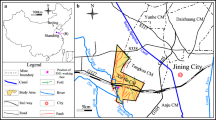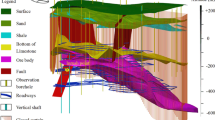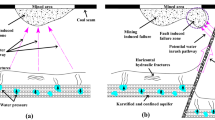Abstract
Mine water inrush is one of the main hazards in coal mining industry. The mechanism and the processes are complex. Investigation of the spatiotemporal development of the hydrological process could lead to a better understanding of mine water inrush and effective countermeasures. For this reason, we investigated spatial and temporal characteristics (i.e., the changes of flow rate, groundwater level, and water quality) during a water inrush event in China, which had a flow rate of 730 m3/h at maximum and 300m3/h under a steady condition. The result shows that the water inrush developed in several stages. A mathematical model of the dynamic change between the water table and the inrush flow rate was constructed. Based on this model, we found the relationship of highly conductive flow channels between some observation boreholes and the water inrush point. In addition, the recharge velocity of the highly conductive flow channels and the equivalent mean flow velocity of the whole mine were determined. A comprehensive analysis of geological, hydrodynamic, and crustal stress conditions was conducted to study the development of the water channel near the F13 fault and the nonlinear process from seepage stage to inrush stage. The result reveals the water inrush is likely caused by activation of faults under combined influences of high crustal stress and high hydraulic pressure.





Similar content being viewed by others
References
Evans JP, Forster CB, Goddard JV (1997) Permeability of fault-related rocks, and implications for hydraulic structure of fault zones. J Struct Geol 19:1393–1404
Li Q, Wang W, Wenqing P et al (2010) Influence of activation fault after coal extraction on coal mine karst water-inrush. Chin J Rock Mech Eng 29(s1):3417–3424 (in Chinese)
Miao X-x, Hai P, Hai-bo B (2008) Principle of water-resisting key strata and its application in water-preserved mining. J China Univ Min Technol 37(1):1–4 (in Chinese)
Ni H-g, Luo G-y (2000) Study on the mechanism of preferred plane of water hazard in coal mine. J China Coal Soc 25(5):518–521 (in Chinese)
Petrie ES, Petrie RA, Evans JP (2014) Identification of reactivation and increased permeability associated with a fault damage zone using a multidisciplinary approach. J Struct Geol 59:37–49. https://doi.org/10.1016/j.coal.2009.06.007
Qian M-g, Xie-xing M, Xu J-l (1996) Theoretical study of key stratum in ground control. J China Coal Soc 21(3):225–230 (in Chinese)
Shi L-q (2009) Summary of research on mechanism of water-inrush from seam floor. J Shandong Univ Sci Technol (Nat Sci) 28(3):17–23 (in Chinese)
Tueckmantel C, Fisher QJ, Grattoni CA, Aplin AC (2012) Single- and two-phase fluid flow properties of cataclastic fault rocks in porous sandstone. J Mar Pet Geol 29:129–142
Wu Q, Fang-peng C, Su-qi Z et al (2013) Type classification and main characteristics of mine water disasters. J China Coal Soc 38(4):561–565 (in Chinese)
Xu J-p, Fu-cheng Z, Hui G et al (2012) Characteristics and experimental study of water conduction caused by fault activation due to mining. J China Univ Min Technol 41(3):415–419
Xue Y (2003) Groundwater hydrology. Geology Publishing House, Beijing (in Chinese)
Zhang W-q, Ming S, Wei A et al (2009) Study on the discrimination of water inrush from deep-well floor based on fuzzy neural network. China Saf Sci J 19(12):61–65 (in Chinese)
Acknowledgements
This work was financially supported by the Fundamental Research Funds for the Central Universities (No. 2014QNB51), A Project Funded by the Priority Academic Program Development of Jiangsu Higher Education Institutions, and the National Natural Science Foundation of China (No. 41572218).The first author is also grateful to the Chinese Scholarship Council for providing scholarship to conduct the research described in this paper as visiting research scholar at the University of Arizona. The fourth author would like to acknowledge the support from the Strategic Environmental Research and Development Program (Grant No. ER-1365), the Environmental Security and Technology Certification Program (Grant No. ER201212), and the National Science Foundation-Division of Earth Sciences (Grant No. 1014594). In addition, he also acknowledges the Outstanding Oversea Professorship award through Jilin University from Department of Education, China, as well as the Global Expert award through Tianjin Normal University from the Thousand Talents Plan of Tianjin City.
Author information
Authors and Affiliations
Corresponding author
Rights and permissions
About this article
Cite this article
Qi, Y., Li, M., Li, K. et al. Spatiotemporal development of mine water inrush and its mechanism—a case study in Ganhe coal mine, Shanxi, China. Arab J Geosci 10, 433 (2017). https://doi.org/10.1007/s12517-017-3216-5
Received:
Accepted:
Published:
DOI: https://doi.org/10.1007/s12517-017-3216-5




